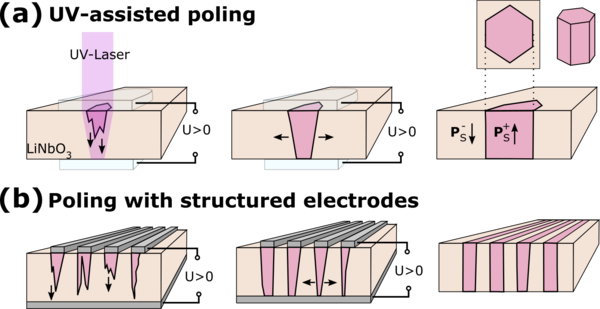Teilprojekt 5
TP5
Tailored domain structures in ferroelectric heterostructures
The present proposal describes a subproject of the research group "Periodic low-dimensional defect structures in polar oxides", which focuses on the correlation of defect structure, electron and ion transport, as well as electromechanical properties in ferroelectric solid solutions using the model system lithium niobate-lithium tantalate.
This subproject is dedicated to investigating and fabricating optical waveguide structures and novel ferroelectric heterostructures using solid-state bonding, as well as tailoring domain structures in such systems. Heterostructures and their interfaces, such as in (epitaxial) layered structures, play a central role in semiconductor technology to tailor specific properties like 2D electron gases, PN junctions, or optoelectronic properties. However, such hetero-systems have not played a role in ferroelectric materials commonly used in optics or piezotechnology. Here, the focus has been on producing remarkably homogeneous or defect-free crystals while tailoring properties through physical structuring or controlling domain structures.
In contrast, this project plans to produce ferroelectric heterostructures using solid-state bonding. Heterostructures, for example, arbitrary stacks of lithium niobate and lithium tantalate (including different cuts), would enable both tailoring macroscopic properties in terms of an effective medium, which is particularly interesting for integrated and quantum optics, as well as the tailoring interfaces and their electronic properties of single crystalline ferroelectrics. Lithium tantalate, for instance, differs in spontaneous polarization. An interface would thus lead to the formation of a space charge layer based on the difference in screening charge carriers, even with the same ferroelectric domain alignment. In combination with domain structures and considering other material properties like electronic bandgaps, defect levels, or polarons, this could enable previously unattainable components, such as PN junctions, through the connection of conductive domain walls in different host systems. Preparing such interfaces and hetero systems in ferroelectrics holds excellent potential for electronics, optics, or piezotronics.
Objectives
- Realization of simple integrated-optical components in LNT
- Fabrication of large-scale tailored domain structures
- Fabrication of ferroelectric heterostructures in LN, LT and LNT

